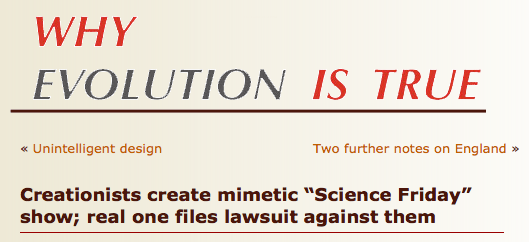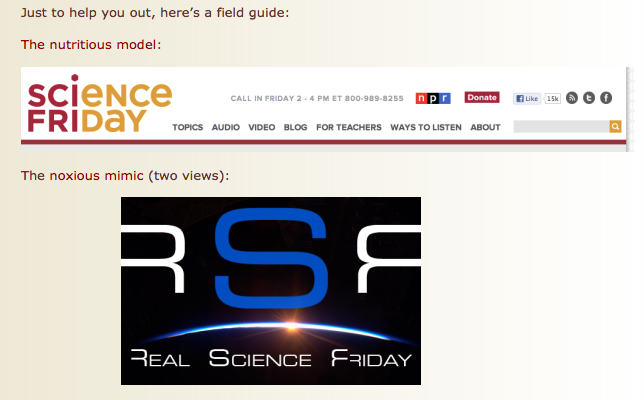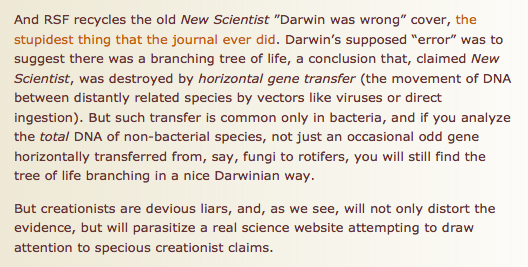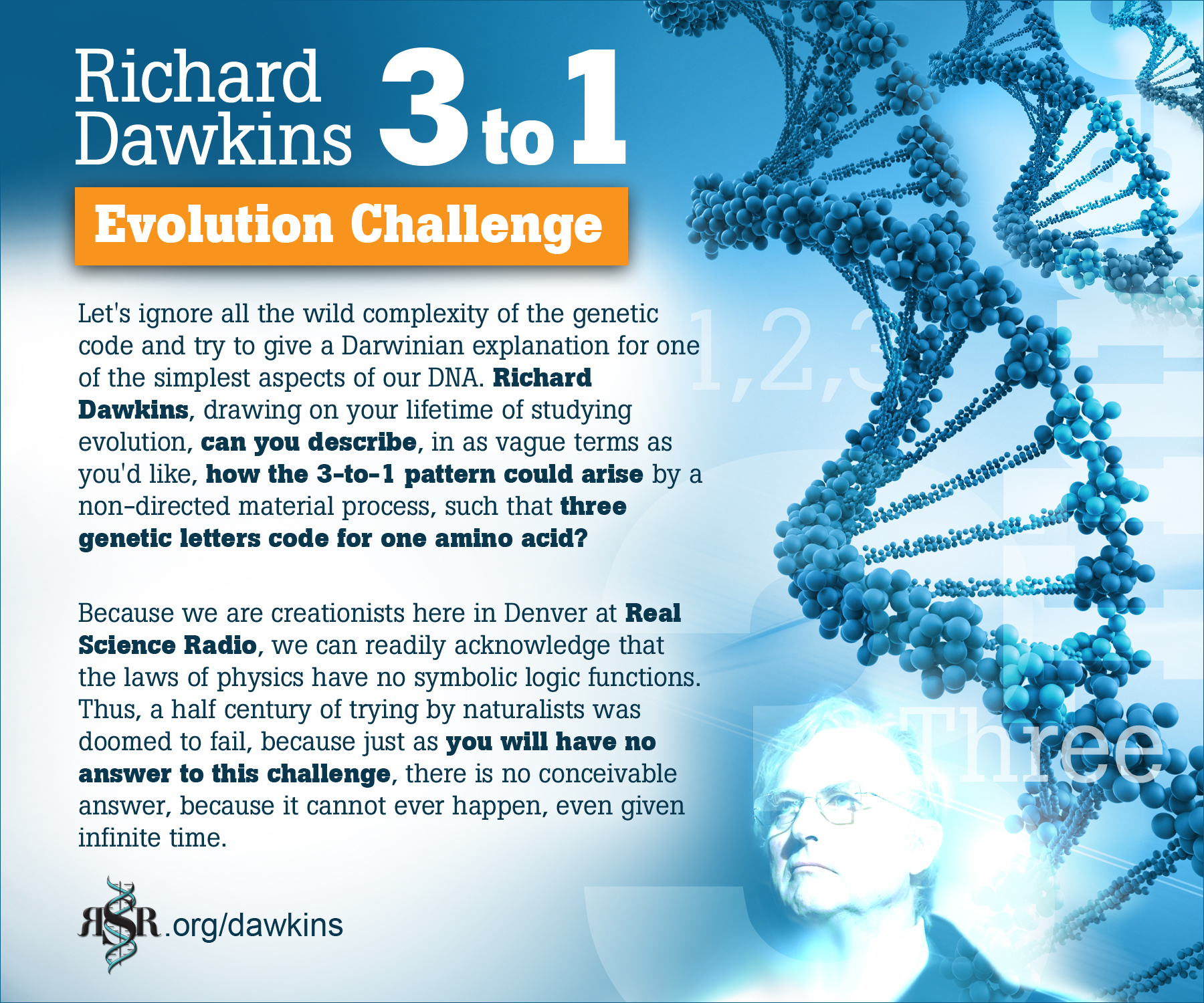 Jerry Coyne is a fruit-fly expert and evolution professor at the University of Chicago, well known for his opposition to creation and for his website Why Evolution Is True. Bob Enyart is a young-earth creationist. So which man would you think, the evolutionist or the creationist, would more accurately understand and present the latest cutting-edge discoveries from the world of genetics, and which one would be in denial? See for yourself...
Jerry Coyne is a fruit-fly expert and evolution professor at the University of Chicago, well known for his opposition to creation and for his website Why Evolution Is True. Bob Enyart is a young-earth creationist. So which man would you think, the evolutionist or the creationist, would more accurately understand and present the latest cutting-edge discoveries from the world of genetics, and which one would be in denial? See for yourself...
 These three screenshots are from Coyne's criticism of "Real Science Friday" (the former name of Real Science Radio) in his Nov. 19, 2012 blog, with the third screenshot presenting his scientific criticism regarding horizontal gene transfer. Following them is the comment that Bob Enyart posted which Jerry has so far rejected from appearing on his blog. First, Coyne's heading...
These three screenshots are from Coyne's criticism of "Real Science Friday" (the former name of Real Science Radio) in his Nov. 19, 2012 blog, with the third screenshot presenting his scientific criticism regarding horizontal gene transfer. Following them is the comment that Bob Enyart posted which Jerry has so far rejected from appearing on his blog. First, Coyne's heading...
And see Jerry's fun visual comparison of the logos (with RSR hoping that National Public Radio's SciFri sticks with their logo and doesn't copy ours ;)
And last, here is the main scientific criticism that Jerry Coyne chose to level against us...
 |
So the question is, on this specific scientific matter, is the famed University of Chicago evolution professor correct, or is the fundamentalist Christian young earth creationist correct? Here's my reply to Prof. Coyne that so far he has not OK'd for display:
Bob Enyart
Your comment is awaiting moderation.
Posted November 20, 2012 at 8:31 am Permalink
 Jerry, yes, you disapprove, but thanks anyway for the blog about us. You claim the same thing that AronRa claimed when I debated him, about the New Scientist ”Darwin was wrong” cover story. The mag says that because of HGT, we should cut down the tree of life. Their specific evidence contradicts your dismissal of their article. You say that:
Jerry, yes, you disapprove, but thanks anyway for the blog about us. You claim the same thing that AronRa claimed when I debated him, about the New Scientist ”Darwin was wrong” cover story. The mag says that because of HGT, we should cut down the tree of life. Their specific evidence contradicts your dismissal of their article. You say that:
...such transfer is common only in bacteria, and if you analyze the total DNA of non-bacterial species, not just an occasional odd gene horizontally transferred from, say, fungi to rotifers, you will still find the tree of life branching in a nice Darwinian way. -Coyne
Yet NS reported that a UC Davis study:
...compared 2000 genes that are common to humans, frogs, sea squirts, sea urchins, fruit flies and nematodes. In theory, [they] should have been able to use the gene sequences to construct an evolutionary tree showing the relationships between the six animals. [They] failed. The problem was that different genes told contradictory evolutionary stories. -New Scientist
NS also reports according to the National Academy of Sciences that:
...ever more incongruous bits of DNA are turning up. Last year, for example, a team at the University of Texas… found a peculiar chunk of DNA in the genomes of eight animals [including] – the mouse, rat, …, little brown bat, … opossum, [a] lizard and [a] frog – but not in 25 others [where Darwin's tree would have it], including [in] humans, elephants, chickens and fish.
As a creationist debating leading anti-creationist Eugenie Scott on nat’l TV in 1998, I predicted that the popular junk DNA argument against creation would eventually be shown otherwise. You might agree that I got the upper hand, as you can hear Eugenie and me sparring at http://kgov.com/journal-nature-junk-not-junk.
Today, I predict that your “common only in bacteria” argument will go the way of Junk DNA, as NS showed, and we show, at http://KGOV.com/genomes
Thanks again Jerry!
If Dr. Coyne's characterization above was wrong, as we believe it was, regarding the nature and extent of the genetic evidence against Darwin's tree of life as described in that NS article, it would be admirable of Coyne to acknowledge that his criticism, therefore, of both New Scientist and of RSR, at least on this single matter, was not justified.
* From RSR's List of Genomes that Just Don't Fit: As we document with links to journal papers and the science press, Jerry, in addition to the evidence in that New Scientist article, geneticists have also found what they typically refer to as startling, unexpected sequence distributions, including that:
- Mouse DNA is the same as 80% of the human genome
- Sponges share 70% of human genes including for nerves and muscles
- Kangaroo DNA unexpectedly contains huge chunks of the human genome
- Gorilla DNA is closer to humans than chimps in 15% of the genome
- Neanderthal DNA is fully human, closer than a chimp is to a chimp
- The chimp Y chromosome is "horrendously different" from our 'Y'
- The human Y is astoundingly similar all over the world lacking the expected mutational variation
- Mitochondrial Eve "would be a mere 6000 years old" by ignoring chimp DNA and calculating by mutation rates
- Roundworms have far more genes than Darwinist predictions,19,000, compared to our 20,500 genes
- The flatworm man-bug "ancestor" genome has "alarmed" evolutionists and is now dislodged from its place at the base.
- The cow genome possesses a surprising piece of snake DNA
- Genomes are so erratic that PNAS reports horizontal gene transfer must have "transformed vertebrate genomes"
- "Genetic diversity exploded in recent millennia" when "vast number of human DNA variants arose only in the past 5,000 years."
* A Question for Jerry Coyne: If the next years of genetic research greatly expand the nonconformist evidence that led to the the NS conclusion, Dr. Coyne, that genetic sequences throughout living organisms significantly and commonly contradict the Darwinian tree of life (like the horse-near-bat PNAS paper), would you agree then that New Scientist was courageously following the evidence before most other scientists were ready to do so?
* A Genome is More Complicated than an Article: The following additional excerpts from the famous New Scientist article that Coyne assesses, show indisputably that he has been completely unable to acknowledge even the scope of raw science that was reported in that landmark article. It is possible that a scientist's bias is so strong that he can't get himself to accurately identify even the extent of the raw data in a 5-page article. So how much more difficult would it be for him to evaluate comparative genomes each with billions of nucleotides, if an objective evaluation were to prove him wrong and his opponents correct?
* More New Scientist Excerpts: from this same New Scientist article affirming the creationist take on this and showing that Coyne dismissively misrepresents as the "occasional odd gene" the great extent of the scientific evidence in this well-known article:
Conventionally, sea squirts - also known as tunicates - are lumped together with frogs, humans and other vertebrates in the phylum Chordata, but the genes were sending mixed signals. Some genes did indeed cluster within the chordates, but others indicated that tunicates should be placed with sea urchins, which aren't chordates. -quote from the New Scientist article that Coyne discounts as being true only for bacteria
Biologist Michael Syvanen of the University of California said that, "Roughly 50 per cent of its genes have one evolutionary history and 50 per cent another… We've just annihilated the tree of life. It's not a tree any more…" -quote from the New Scientist article that Coyne discounts as being true only for bacteria
But today the project [to reconstruct the tree] lies in tatters, torn to pieces by an onslaught of negative evidence. Many biologists now argue that the tree concept is obsolete and needs to be discarded. "We have no evidence at all that the tree of life is a reality," says [an evolutionary biologist from Marie Curie University in Paris, Eric] Bapteste. -quote from the New Scientist article that Coyne discounts as being true only for bacteria
RNA, for example, might suggest that species A was more closely related to species B than species C, but a tree made from DNA would suggest the reverse. -quote from the New Scientist article that Coyne discounts as being true only for bacteria
And to make matters worse, protein sequencing might suggest yet a third evolutionary pathway, and then all of these were producing trees that contradicted the traditional pathways based on fossil evidence and anatomy. -quote from the New Scientist article that Coyne discounts as being true only for bacteria
Far from New Scientist's evidence referring primarily to microorganisms and only an occasional tip of a branch on the tree, the landmark article mentions single-celled organisms only to show that what is known of them is also common for organisms throughout the tree of life:
Having uprooted the tree of unicellular life, biologists are now taking their axes to the remaining branches. --quote from the New Scientist article that Coyne discounts as being true only for bacteria
And when they report something that Coyne suggests is their primary evidence, that prokaryotes (organisms without a nucleus) cannot be fit to Darwin's hierarchical tree of life, they do so only to explain that this is the rule for eukaryotes, which would include all plants and animals. For example, as also reported in NS and in the Proceedings of the National Academy of Sciences, European researchers:
…examined more than half a million genes from 181 prokaryotes and found that 80 per cent of them showed signs of horizontal transfer [i.e., not Darwinian hierarchy]. Surprisingly, HGT also turns out to be the rule rather than the exception in the third great domain of life, the eukaryotes. -New Scientist
Detecting a trend requires multiple data points. So, how about these three: the Darwin evangelists dismissing the powerful evidence against the junk DNA claims; the Darwinists dismissing the evidence for dinosaur soft tissue, and now, rejecting the extent of nonconformist DNA. In a written debate with RSR, an anti-creationist with millions of YouTube views, AronRa, had a false representation similar to Coyne's, writing that, "Bob Enyart... got all of the details in that article wrong. The article was about horizontal gene transfer, it did focus primarily on microbes, and was not about human DNA. Nor did it offer any significant challenge to the "tree-of-life" -at least where that pertains to multicellular organisms, and especially animals." This goes beyond a disagreement over conclusions, and is more a refusal to even acknowledge the existence of the evidence. Likewise, evolutionists that we've confronted for years, argued, as though we had entered a twilight zone, that the journal papers claiming the discovery of dinosaur soft tissue were not even claiming the discovery of dinosaur soft tissue, but of something else (like mere impressions; like demineralizing solution re-sequencing proteins; like acid turning rock back into tissue; with examples of this behavior at Britain's League of Reason). We find this kind of intense and group-think denial common among evolutionists, to which we can now add Jerry Coyne's dismissive mischaracterization of even the extent of the New Scientist evidence. Thus his blog's scientific argument against Real Science Radio seems merely to present more evidence of the denial of even the existence of contrary scientific evidence among Darwinists.
* Holy Cow Jerry: The Darwinian tree of life would be drawn, based on anatomy, fossils, and the evolution story, showing a cow and a horse somewhat closely related, with bats flittering about elsewhere on the tree. Now though, after prokaryote studies took a stump grinder to the base of the tree, study after study, as in this peer-reviewed paper in the Proceedings of the Nat'l Academy of Sciences, is taking a wood chipper to the eukaryotes throughout the branches. As explained (in plain English) by New Scientist, disregarding anatomy and the traditional tree, geneticists have redrawn the tree of life, based on DNA sequencing, to claim now that horses are more closely related to bats than to cows. Holy cow Jerry, this is all a lot more than "an odd gene" here and there.
* RELATED: MicroRNA Chopping Down Darwin's Tree: From Nature, June 2012, "Tiny molecules called microRNAs are tearing apart traditional ideas about the animal family tree." Says Dr. Kevin Peterson, "I've looked at thousands of microRNA genes, and I can't find a single example that would support the traditional tree." The Dartmouth biologist "had originally intended to validate the traditional mammal tree, not chop it down. As he was experimenting with his growing microRNA library, he applied it to mammals because their tree was so well established that they seemed an ideal test. Alas, the data didn't cooperate. If the traditional tree was correct, then an unprecedented number of microRNA genes would have to have been lost, and Peterson considers that highly unlikely. 'The microRNAs are totally unambiguous,' he says, 'but they give a totally different tree from what everyone else wants.'"
* RELATED: Phylogenetic Incongruence: From the Nov. 2012 paper in the Biological Reviews of the Cambridge Philosophical Society, titled Understanding phylogenetic incongruence: lessons from phyllostomid bats, the authors, while putting the best Darwinist face possible on their findings, admit: "Incongruence among phylogenies [i.e., assumed evolutionary family trees] estimated from different sets of [genetic] characters is pervasive… Phylogenetic conflict has become a more acute problem with the advent of genome- scale data sets. These large data sets have confirmed that phylogenetic conflict is common, and frequently the norm rather than the exception…" Also, "Our analyses have shown that… there is significant incongruence between phylogenies derived from morphological and molecular data..."
Then, on another topic, Dr. Coyne's blog hasn't approved this comment either, to another reader:
Your comment is awaiting moderation.
Posted November 20, 2012 at 8:21 am Permalink
Hello Lou Jost, your report on rapid fly honeybee mimicry is fascinating. Hyper-fast, and yet, at our KGOV .com/list-of-not-so-old-things#bees we have, linking to PLoS One, that Asiatic and European honeybees have allegedly been separated supposedly for seven million years. Yet researchers put the two together, and rather than the expected loss of ability to communicate, the bees still communicate. Should even humans, separated for 7,000 years, let alone millions, retain such ability? An objective scientist should then question the claimed years of separation.
And a day later:
Bob Enyart
Your comment is awaiting moderation.
Posted November 21, 2012 at 12:23 pm Permalink
Jerry, did I violate any of your blog guidelines with my previous two comments? If not, if you didn’t approve them because you just don’t want me responding to you about your comments about me, that’s fine. I’ll try to remember to avoid commenting here in the future. Thanks, -Bob Enyart
We note happily that while PZ Myers' blog is overtly hateful and filthy in its derogatory claims and constant reference to defecation, sex organs and acts (see realscienceradio.com/PZ#filthy, at first take, Coyne's blog, while equally in disagreement with creationists, is far more civilized.
* UPDATE Nov. 23, 2012: Apparently, Dr. Coyne has decided against publishing the above comments since he has deleted them from the queue of comments pending approval. If Dr. Coyne ever invites Bob Enyart to reply to the above accusations, we will note that here.
Tune in Fridays to Real Science Radio and anytime at realscienceradio.com!
Don't miss our DinosaurSoftTissue.com and YoungEarth.com!
* UPDATE 2014: A couple years later Bob Enyart again submitted a comment to Jerry Coyne's blog, quoting this anti-creationist who had written about , "Note that the DI will continue to ignore negative verdicts [about Stephen Meyer's book Darwin's Doubt] by scientists like Matzke..." Enyart added, "Just fyi, if you read the newly released paperback, you'll see that Meyer addresses Matzke's critique at length. For example, Meyer addresses the claim that the hypothetical creatures inferred by conflicting cladograms provide sufficient evidence of the actual existence of such transitional forms." That was on May 30, 2014 and the comment would have been #22. If you notice that Jerry decides this time to post Bob's comment, feel free to let us know at Bob@RealScienceRadio.com.
* October 2017 Update: After Richard Dawkins commented on Jerry Coyne's blog, Bob Enyart replied (and we're waiting to see if Coyne's permits the comment to be displayed)...
 Unfortunately, Dr. Jerry Coyne refused to permit my comment to be displayed on his blog, even though I've interviewed so many of those who move in his circles and even though he and I had the above spat five years ago. (Here are those links rsr.org/dawkins-3-to-1, rsr.org/genomes, and rsr.org/junk and an archive.)
Unfortunately, Dr. Jerry Coyne refused to permit my comment to be displayed on his blog, even though I've interviewed so many of those who move in his circles and even though he and I had the above spat five years ago. (Here are those links rsr.org/dawkins-3-to-1, rsr.org/genomes, and rsr.org/junk and an archive.)

